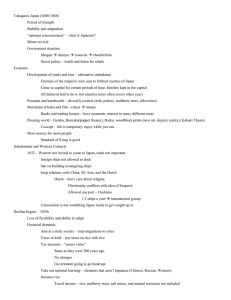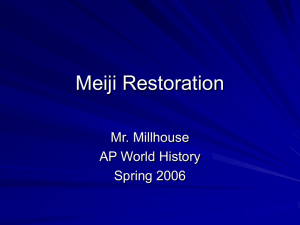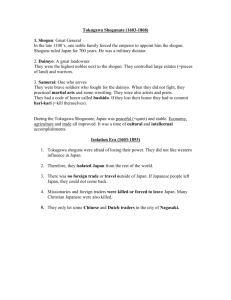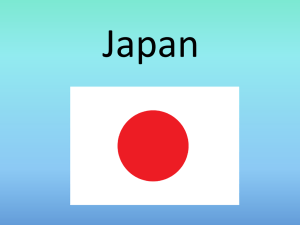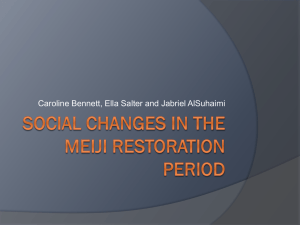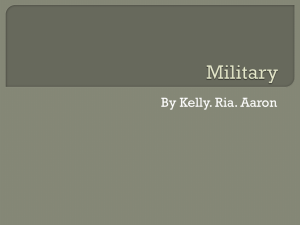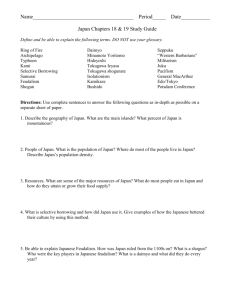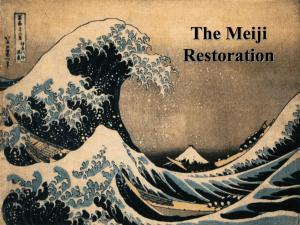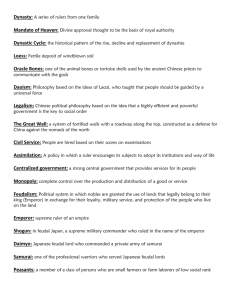Politcs of meiji restoration
advertisement
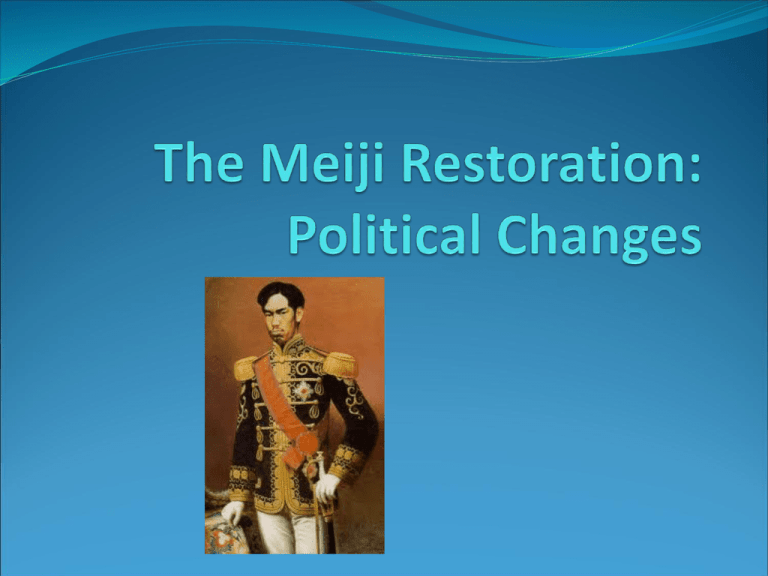
Introduction 3 January 1868: Iwakura Tomomi, a court noble with ties to both Tozama daimyo; Choshu and Satsuma, is granted an imperial rescript declaring the abolition of the shogunate and imperial restoration is declared Yoshinobu, the Shogun flees to Shizuoka New Emperor 15 year-old emperor Mutsuhiro was “restored” to the throne. He took the reign title of Meiji(Enlightened rule) However, most power was not transferred to him but to the hands of the tozama that had lead the movement which brought about the demise of the shogunate (Choshu and Satsuma) There were 100 of these so-called advisors or regents that governed the nation on the emperor’s behalf The Meiji emperor’s reign oversaw an abundance of dramatic changes in Japan as many Western ideas were adopted. Charter Oath April 1868 the emperor issued 5 article oath: “1- Deliberative assemblies shall be widely established and all matters decided by public discussion 2- All classes, high and low, shall unite in vigorously carrying out the administration of affairs of state 3- The common people, no less than the civil and military officials, shall each be allowed to pursue his own calling so that there may be discontent. 4- Evil customs of the past shall be broken off and everything based upon the laws of nature 5- Knowledge shall be sought throughout the world so as to strengthen the foundations of imperial rule” Charter Oath Final point of oath is noteworthy - There was a stark controst between this point and the shogunate’s isolationist policy and sakoku jidai (isolationist period) Evidence of willingness to embrace western thinking for the benefit of Japan’s military and economic development New Government 1868 The Deliberative Assembly (Daijokan) is established Two bodies constituted the Deliberative Assembly: Council of State (Upper house) and Assembly (Lower house) In reality the majority of power was yielded by the Council of State, dominated by the powerful former tozama daimyo clans of Satsuma, Choshu, Hizen and Tosa The council members maintained a low-profile. Yet, they were an oligarchy which ruled Japan and oversaw its governing and administrative proceedings End of Feudalism The Tokugawa shogunate was characterised the highly centralised version of feudalism it had adopted. Dismantling feudalism in Japan was one of the aims of the ruling oligarchy. Hence, the demise of the shogunate and resulting Meiji restoration coincided with the end of feudalism and the bafuku system in which daimyo’s ruled over their own domains 1868Imperial officials were appointed to every feudal region. This was to emphasise to the daimyo the growing influence of the central government. Daimyo Reactions to the end of Feudalism Western Daimyo clans willingly surrendered their powers to central government. The rest were forced to. They were granted compensation in the form of substantial pensions and all debts were paid. They were permitted to act as governors of their previously held domains+ they were granted titles in new nobility. Subsequently, most daimyo were satisfied. They enjoyed prosperity and prestige. Their fortunes had changed dramatically from the later stages of the Tokugawa shogunate, when merchants began their ascent in society at the expense of the daimyo. Samurai Reactions to abandonment of Feudalism Peace time during the Tokugawa shoguante had facilitated the demise of the samurai. Many were forced to give up their positions as warriors and take up teaching. The Meiji restoration and its forfeit of the feudal system simply exacerbated their plight. They were given pensions not even sufficient for subsistence. Consequently, many sought other sources of income. This fueled discontent among the samurai Samurai Reactions to abandonment of Feudalism 1876 Pensions proved burden for government. They were replaced by single lump sum. Many samurai were incensed by this decision and joined the private army led by Saigo Takamori This anger manifested itself in an open rebellion in 1877 Ministry of Education Meiji placed an emphasis on education as they recognised it could serve as a medium for progress 1871- Ministry of education established By 1906, 95% if Japanese children were gaining a primary education There was a large Western presence in education. Western subjects were taught: English, Maths, Science and there were many foreign teachers All students were indoctrinated in unwavering devtion to the Emperor Legal Reforms The government felt humiliated by the concessions made by the Tokugawa shogunate, notbaly extra-territoriality which implied Japanese law was less civilised than Western Law. 1871 A Judicial department was established By 1889- Civil+Criminal law revised and codified 1899- Extra-territorial rights dropped allowing foreigners to be subject to be Japanese law Implying that the stature of the Japanese in terms of civilisation had risen in Western Eyes. Factionalism within the Oligarchy There were underlying tensions and divisions between the Military Beareaucrats who wanted to strengthen Japan through foreign wars and Civil Bureaucrats who wanted peace and consolidation 1871 Loochoo Islands incident. Japan demanded compensation. China refused military party wanted to declare war. Peace party resisted demands for war. Saigo Takomori (Satsuma)= Leader of Military Bureaucrats wanted to carry out invasion of Korea. Majority peace party objected as it could lead to complications with Russia. Peace party believed that Japan should first strengthen its economic position before embarking on such military ventures Saigo Takamori Saigo Takamori and his supporters withdrew from the government and became highly critical of the government’s policy of conscription His opposition was often violent This discontent came to a climax in the form of a rebellion in 1877 Itagaki Taisuke Another critic of the government. Prominent in demanding the establish of representative government (pushing towards a form of democracy) He was clearly influenced by liberal Western thinking. This concept was alien to the Japanese Politcal Parties The government was being inundated by demands for a form of representational government Japan’s first politcal party the Jiyuto(Liberal Party) Then in 1881 the Kashinto (progressive party) was formed by Okuma Shigenobu of the Hizen clan after he was forced out of government by politcal opponents The two parties did not cooperate, making it exceptionally easy for the government to keep a tight lid on their activities and monitor them Constitution 1881- Emperor announced that a constitution was to be drawn up 1889- The Emperor handed the constitution to the PM, count Kuroda. It was emphasised that the document was not a concession given after the emperor had caved in to demands, but that it was a gift to the people. Ito Hirobumi became Japan’s first prime-minister Terms of the Constitution It stressed the Emperor was head of state. The cabinet were the Emperor’s subordinates, not the diet’s the diet was made up of two houses: House of Peers (life appointments given by Emperor)and the House of Representatives (elected every 4 years) However, only 5% had the right to vote, making it a rather fraud representative government
